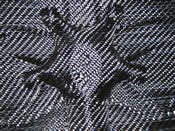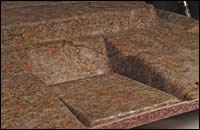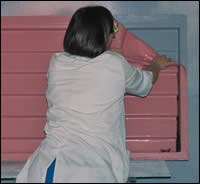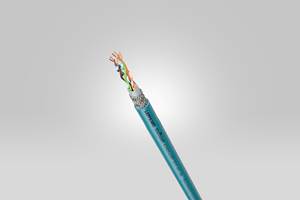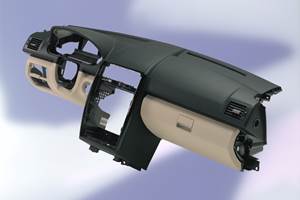Composites–Part II New Reinforcements and Materials At Paris JEC Show
Part II of our review of the biggest international composites show focuses on new reinforcements, resins, prepregs, and additives. Thermoplastics were a particularly strong presence.
Topping the raw-materials news at the big JEC international composites show in Paris last April, was increasing use of natural and thermoplastic fibers, “hybrid” fiber combinations, small-diameter glass fibers, and prepregs tailored to put certain types of fibers in specific locations where strength or stiffness are needed.
Also new at the show were cores and prepregs designed to use less resin and reduce weight without sacrificing strength. Some new prepregs combine thermosets and thermoplastics to reduce weight and improve toughness. (For Part I of our JEC report, see Learn More box.)
‘Hybrid’ fiber products
F.T.S. Fibre e Tessuti Speciali SpA (div. of Ozella SpA) in Italy, won the top JEC innovation prize this year in partnership with EMS-Griltech (div. of EMS-Chemie), a Swiss maker of nylon adhesive fibers. The prize was given for a woven fabric called Phoenitex, which contains thermoplastic phenoxy yarn (made by EMS-Griltech) oriented at 90° to unidirectional or woven carbon and aramid fibers. This fabric is calendered to melt and weld the phenoxy yarn to the fibers. The unidirectional fabrics are then stacked and preformed to consolidate them further, so the fibers don’t distort during RTM processing. Thermoset epoxy is injected into the fabric and cured at or above the melt temperature of the phenoxy yarn. The material is used in seat frames for high-performance Italian racing cars.
Two companies showed hybrid fabrics that combine natural and thermoplastic fibers. For automotive headliners, Milliken & Co. is commercializing Halo nonwovens of a 50/50 blend of PP and kenaf fibers. Milliken concentrates PP fibers in specific locations to reinforce the preform. Headliners are a new application for PP/natural-fiber fabrics, which are already used in car door panels and rear package shelves. Headliners require more strength and stiffness in certain places to support other components. Halo comes in weights from 800 to 2000 g/m2.
CRST SA in France showed new unidirectional fabrics that combine long-fiber hemp with various ratios of thermoplastic fibers such as nylon, PP, or PEEK. CRST offers fabrics with up to three unidirectional layers as well as a new all-hemp unidirectional fabric.
SGL Group and Kuempers High Performance Textiles of Germany created a joint venture this year to develop new textile preform products combining SGL’s carbon fibers and Kuempers’ E-glass yarn. The new German company, SGL Kuempers (U.S. office at SGL Technic), is developing 3D textile preforms using both fibers. Substituting carbon fiber for glass saves weight for aviation, wind energy, automotive, and industrial applications.
Glass fibers slim down
Two makers of glass reinforcements introduced very thin fibers. One is S-glass reinforcement for composite armor. The other is chopped E-glass for micro-injection molded parts. AGY Holding Corp. introduced a 7-micron-diam. S-2 glass fiber that is far thinner than any other commercial roving. Previously, AGY’s smallest was 9 microns. Other producers make high strength glass in the 18- to 26-micron range. Fibers with finer diameter have higher strength than thicker filaments. Their increased surface area also improves ballistic performance, and they can produce panels that are 5% to 10% lighter.
Owens Corning last year introduced MicroMax chopped E-glass fibers in a smaller diameter–6 to 7 mm–to reinforce micromolded parts for cell phones and other miniature electronics. Owens Corning acquired the MicroMax technology with its purchase of the composites business of Asahi Glass Co. in Japan. The chopped mini fibers were previously available only in Japan. Besides smaller size, MicroMax fibers use advanced binders that produce low off-gassing. MicroMax chopped strands come in two versions: 798 (sized for PPS) and 771 (sized for nylon 66). Though not the thinnest E-glass fibers available (AGY makes 4-micron fiber for yarns and fabrics), they are the thinnest offered in chopped form.
Owens Corning also has three developmental HiPer-tex glass fibers undergoing trials. They are FliteStrand for aviation applications, ShieldStrand for ballistic protection, and XStrand for industrial applications such as pressurized containers and sporting goods. HiPer-tex fibers (currently available as WindStrand products for wind blades) are said to have up to 35% higher strength, up to 15% higher modulus, and up to 70% better impact toughness than conventional E-glass, as well as greater fatigue and corrosion resistance and up to 30% lower CLTE.
Sinoma Science & Technology Co. in China showed its High Strength Glass, which has tensile strength of 480 to 550 kpsi, comparable to the low end of S-2 glass (550 to 650 kpsi) and tensile modulus of 12 to 13 Mpsi, the same as S-2 glass. Density is lower than E-glass–2.53 to 2.54 g/cc vs 2.55 to 2.64 g/cc for E-glass. PPG Industries is the exclusive distributor for the Americas (excluding Brazil). These HS2 and HS4 products are available in rovings (240 to 2400 tex), bobbin yarns, and fabrics for aerospace, security, and industrial applications.
Among several new veils at the show, highly conductive nonwoven veils of nickel-coated carbon fibers were presented for lightning-strike protection by Hollingsworth & Vose Co. Panels made with one of the new veils passed the most severe Zone 1A (direct lightning) strike test. Nonwovens are easier to handle than conventional metallic meshes and don’t need to be isolated from galvanic reactions with other materials. Veils are available in eight basis weights from 0.35 to 1.39 oz/sq yd and 0.07 to 0.25 mm caliper.
CPIC/Fiberglass in China introduced a very light E-glass veil (35 g/m2). It’s available here from Ashland Distribution.
News in thermoplastics
Several companies showed new thermoplastic core materials. Plascore Inc. displayed a core of PP honeycomb covered on both sides with a nonwoven PP veil and PP film to make the core impermeable to laminating adhesive when made into panels. Cores come with 8- and 10-mm-diam. cells.
Lantor bv in the Netherlands reduced the weight of closed-mold parts made with its Soric hexagonal polyester fleece core by adding paste containing expandable plastic microspheres from Akzo Nobel. Previous Soric fleeces contained lesser amounts of the microspheres filled with blowing agent. Developmental Soric LRC (low resin consumption) with additional spheres reduces composite part weight by another 20% to 35%, Lantor says. It is being tested in a 2-mm-thick version, but Lantor expects to offer a 6- to 8-mm LRC core later this year for large, lightweight RTM and vacuum-infusion parts for wind energy and mass transit.
Also aiming to reduce part weight, ESC Extended Structured Composites GmbH in Germany narrowed the gap between the hexagonal blocks in its PET foam core by using smaller connectors. Smaller gaps take half as much resin to fill as before, reducing part weight to 200 g/m2 vs. over 1000 g/m2 before. ESC’s hexagonal foam cores are available with three gap sizes: 0.2, 0.4, and the original 0.7 mm.
J.H. Ziegler GmbH in Germany introduced a PET version of its HACO-loft coarse, needle-punched, nonwoven cores. Originally available only with PP fibers, HACOloft needle-punched PET nonwovens come as cores, breather films, and surface films.
More thermoplastics
Aptiform is a new U.K. firm that was founded to mold components from “self-reinforced” PET made of high-tenacity PET fibers in a PET matrix of a lower melt temperature. A similar approach has been used with self-reinforced PP, but PET has a higher HDT and can be formed with single-sided tooling, whereas PP requires matched-metal molds because it shrinks with more force than PET.
Self-reinforced PET reportedly can replace glass-reinforced thermosets in large, low-volume parts like panels for mass-transit and construction vehicles. Self-reinforced thermoplastics offer weight savings and scrap recyclability. Fabrics can either be woven or unidirectional cross-plies.
Formable thermoplastic sheet is the basis of a developmental car hood molded for GE Plastics by Ranger SpA in Carate Brianza, Italy. The hood has very high energy absorption for pedestrian impact protection. It uses Azdel sheet from GE’s joint venture with PPG. The sheet has a low-density core of random glass-filled PBT sandwiched between 90° layers of unidirectional glass fiber. The glass is wetted out with GE’s Xenoy PC/PBT. GE presented an Azdel hood for Hyundai’s QarmaQ demonstration car in March at the 77th Geneva Motor Show in Switzerland.
The Leibnitz Institute of Polymer Research in Dresden, Germany, is developing commingled yarns of fiberglass and maleic anhydride-grafted PP. They will be used in knitted fabrics for Volkswagen. The yarns, which are similar to Saint-Gobain Vetrotex’s Twintex, have been made into warp-knit fabrics by two German textile companies, Karl Mayer Malimo Textilmaschinenfabrik GmbH and Cetex Chemnitzer Textilmaschinenentwicklung GmbH. The yarn is also being used for biaxial knits, which drape better into deep-draw tooling than warp knits. The Institute believes these are the first knitted textiles combining PP and fiberglass.
Thermoset prepregs & SMC
Nanoledge in France showed its first prepreg (Prepreg One), which consists of a tissue of carbon fibers impregnated with epoxy and a sprinkling of carbon nanotubes to add strength. It’s commercial in high-performance skis.
Simex Technologies Inc. in Montreal introduced a new grade of its fast-curing vinyl ester Simprex prepregs. It cures in 15 to 20 min at 250 F, vs. 1 to 2 hr for epoxy prepregs. Simprex also has much longer shelf life than epoxy—12 months at 70 F vs. 1 to 12 weeks for epoxy prepregs, which need refrigeration. Simprex prepregs also cost 20% to 30% less than epoxy prepregs.
The new Simprex 730 grade has a Tg of 120 to 125 C. Previous grades range from 115 to 190 C Tg. They contain E-glass, carbon, or other fibers and are aimed at automotive, sports, and industrial applications requiring high strength and chemical resistance.
Polynt SpA (a unit of Lonza) in Italy introduced a carbon-fiber SMC, called HUF CF 24/54 RB-9500. It’s a modified vinyl ester with chopped carbon fibers that is said to provide 20% lower density and three times greater stiffness than fiberglass SMC. It permits weight savings of up to 50%, Polynt says.
Huachang Polymer Co. in China showed new MFE-9 elastomer-modified vinyl ester for greater crash resistance in railroad cars.
New films and tapes
For vacuum-bag molding, Aerovac Systems Ltd. in the U.K. (sister company of Richmond Aircraft Products here) introduced RVCS (reusable vacuum cavity sealing) with a semi-rigid rubber frame supporting a diaphragm. It’s for complex shapes and very large molds with low-temperature vacuum systems.
Airtech International Inc. introduced a Sprayable Multi-Bag kit, as well as a Brushable Multi-Bag kit. It uses a low-viscosity paste with reinforcing fabric (RVB Mesh 1) to create a reusable silicone vacuum bag for large parts like boat hulls and car body parts. Multi-Bag cures in thick sections, accelerated by moisture in the air. It comes with a spray gun, regulator, mixer, and nozzle. Replaceable cartridges of the paste material are sold separately.
Airtech also introduced Beta 8610 film adhesive for aerospace applications, designed to provide very long “out life” of one year at 72 F. Film adhesives typically can be used for no longer than a month at room temperature. Airtech also introduced reusable resin infusion connections for vacuum infusion processes.
Another product to reduce waste is Ziegler’s new bleeder tape, only 2 in. wide, aimed at wind blades. The 2-in. tape is applied just where needed—in the drains of molds to keep resin out of the vacuum pumps. Bleeder film typically covers the entire width of a part and is thrown away after one use.
Amcor Flexibles presented several unique films to composites fabricators. Amcor’s film made of high-temperature Mitsui TPX polymethylpentene thermoplastic is used as a release film for wind blades. Amcor’s PPS film is being used to make thermoformable panels that replace aluminum panels in aircraft fuselages. The film is laminated to carbon fiber in stacks of up to 10 layers. When compression molded, the PPS melts into the carbon fiber.
Hexcel Corp. showed its first surface film, HexPly XF3, for producing high surface finish in automotive prepreg applications. The film comes in weights of 150 and 300 g/m2 and is up to 1.25 m wide. It’s used on the new Alfa Romeo 8C sports car.
Scott Bader Composites in the U.K. launched a new spray-on/peel-off mold-protection film to keep stored molds from rusting. Called Crystic Mouldguard, it can be sprayed or brushed onto molds that have been prepared with release agent. The coating cures quickly with the addition of 2% MEKP catalyst and peels off easily when the mold comes out of storage.
New additives
Lubrizol Advanced Materials introduced Solplus D550, a dispersant for inorganic pigments and mineral fillers in open-molded polyesters. Solplus D550 reportedly doesn’t interfere with cure. Doses of 0.5 to 2% dispersant, added to the resin before the filler, reportedly allows faster wetting of ATH, CaCO3 and TiO2 at higher fill levels.
Byk-Chemie introduced Byk-C 8000 coupling agent, which chemically bonds mineral fillers like silica sand into polymer cement. Byk-C 8000 is said to improve strength by more than 50%. Recommended loading is 0.1% to 0.3%.
Akzo Nobel Chemicals introduced an organic peroxide tailored to cure NPG-based isophthalic gelcoats. Butanox P-50 is a patented methyl isopropylketone peroxide, said to be faster reacting than MEKP. It reportedly results in less fiber print-through on the surface of the gelcoat, higher gloss, and faster demolding.
Related Content
Biobased TPU for Broad Range of Applications
BASF’s Elastollan N contains 50% renewable raw material.
Read MoreTracing the History of Polymeric Materials -- Part 29: Polyurethane
This material family has unparalleled versatility, not only in terms of the forms the material can take, but in the different ways in which it can be processed.
Read MoreKraiburg TPE Expands Range of TPEs with ISCC PLUS Certification
The expanded range supports customers in the consumer and medical sectors in next steps toward a circular economy.
Read MoreMedical Grade TPEs for Biopharmaceutical Tubing
Teknor Apex expands its Medalist TPE portfolio.
Read MoreRead Next
Composites Getting Faster and More Automated
Molds that can change configuration, automated tape laying and winding, robotic sprayup, and faster prepreg molding processes highlighted the focus on productivity at the international composites show in Paris. RTM innovations round out this news report.
Read MoreMaking the Circular Economy a Reality
Driven by brand owner demands and new worldwide legislation, the entire supply chain is working toward the shift to circularity, with some evidence the circular economy has already begun.
Read MoreFor PLASTICS' CEO Seaholm, NPE to Shine Light on Sustainability Successes
With advocacy, communication and sustainability as three main pillars, Seaholm leads a trade association to NPE that ‘is more active today than we have ever been.’
Read More




